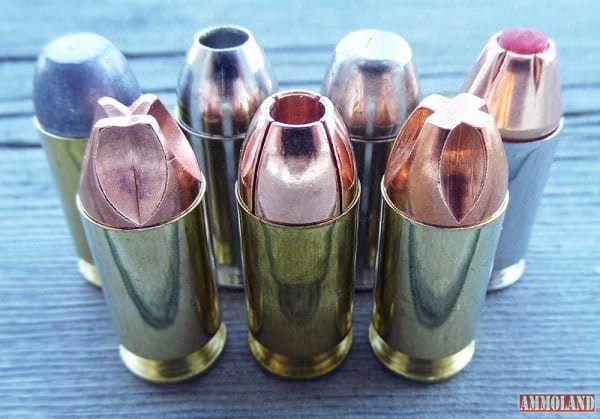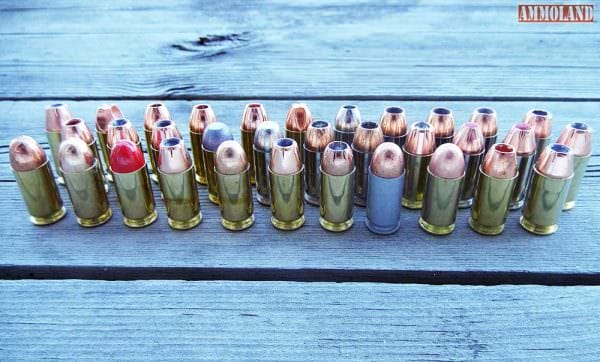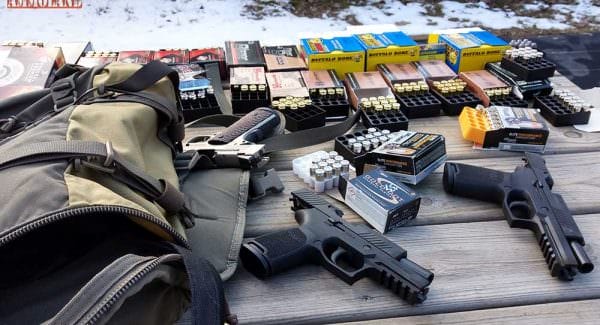By Josh Wayner
Gun writer, Josh Wayner, reveals the results of his extensive .45 ACP velocity trial, putting the classic caliber to the test.


USA – -(Ammoland.com)- I got into a discussion with several local gentlemen over last Christmas about things typical to those who frequent gun stores.
I wouldn’t call it a debate, however there were some sideways comments and tense laughs across the course of the conversation. The countertop became a courtroom of sorts and I found myself in the middle of a caliber war, this time about the merits of the .45 ACP.
The chambering is massively popular all over the country and, at the same time, is subject to nearly endless criticism over why exactly it has survived into our modern era. As is the case with many 100-year-plus cartridges, the following of the .45 ACP is based in practicality and myth in equal amounts. This .45 ACP velocity study was designed to shed some light on the idea that the .45 ACP has either surpassed other cartridges in terms of power and utility or finally reached obsolescence.
In other words, have the modern advances in the 45 ACP cartridge made up for the criticisms leveled against it?
To get a picture of the modern .45 ACP’s velocity, I contacted several manufacturers and received 33 ammunition offerings to test. The ammunition I received ranged from simple ball loads to exotic self-defense rounds that could easily be called art due to the quality of their machining. Every load and weapon tested are currently commercially available and unaltered from their factory form. What you see is what you get here.

45 ACP Muzzle Velocity
A main critique of the .45 ACP is the perceived lack of muzzle velocity when compared to other popular calibers like 9×19 or 10mm Auto. Why would anyone want a caliber that offers both low capacity and low speed? I sure as hell wouldn’t. The other camp I often encounter and debate argues that the .45 ACP offers a profound advantage due to the bullet mass and ‘stopping power’ available, the adage being that one .45 is worth two or three ‘little nines’ in a fight.
I found that the truth lies somewhere in the middle of these points of view based on my results.
Testing was done using an Oehler 35P Proof Chronograph at a distance of five feet from the muzzle in a testing environment of 30 degrees Fahrenheit. Some of you may believe that this is too cold to test reliably, but a sampling of loads were tested at both air temperature and at a warm seventy degrees. The colder temperature allows the guns to remain cool between strings and remove error due to the weapon heating up. With rifles this can make a difference, especially at long range. I detected no significant velocity shift in the loads tested with any pistols. The minute variances were not even outside of standard deviation.
The results proved interesting to say the least. A test this big is best summed up in graphs and some narration to explain what I found. The first thing I noticed was that across all loads and guns, the .45 ACP in any form is essentially the same in a short 3.3” barrel and a standard 5”.
The compiled .45 ACP velocity data points are an average of six (6) readings over the Oehler 35P. Some of you may wonder why there are no error bars and readings for standard deviation and there is a good explanation. This massive test comprised of over a thousand separate data points and the sheer amount of information wouldn’t translate reliably into this article or help to illustrate the results. The enterprising statisticians among you will have to settle for this more practical display.
. 45 ACP Velocity Testing Results:
The . 45 ACP Velocity vs Barrel Factor
When I began this . 45 ACP velocity adventure, I was imagining that there would be a large difference between the standard 5” barrel and the short 3.3” on the S&W Shield. It was my hypothesis that the shorter barrel would be negatively impacted due to the large amount of material being accelerated down the bore. I knew that rifle calibers such as .308 didn’t lose much if anything going from 26” to 13.5”, so imagine my surprise when the exact results came about from my most recent test.
The most unexpected thing aside from the general similarity of all loads across all barrel lengths was that the longest barrel wasn’t the fastest. The 5” 1911 is a standard for the .45 ACP and I found that it was playing a close game with Sig’s 4.7” P320.
The two guns were virtually indistinguishable over the chronograph and had a typical variance so low that it could be said the performance was identical.
Curiously, the Sig P320C with a 3.9” barrel was, by all accounts, only lagging behind the longer guns by a hair, and in some cases was actually faster. All the Buffalo Bore Ammunition ( www.buffalobore.com ) loads performed with little to no variance across any barrel length. In a remarkable display of performance, the Lehigh Defense ( www.lehighdefense.com ) .120gr load had a variance of only 29fps across the average velocities from all four barrels!

The Shield 45 did shockingly well in my . 45 ACP velocity testing considering that it is shorter than most people think a .45 ACP handgun should be. I would go so far as to say that in terms of functional lethality, the short 3.3” barrel loses nothing to the longer barrels. The traditional arguments still prevail in some ways. The larger guns are easier to aim due to a longer sight radius, but they suffer from a weight penalty and low capacity for their size. The Shield loses in no areas in my mind. The weapon has the same capacity as the 1911 with seven or eight rounds onboard, but is less than half the weight. In fact, the Smith & Wesson Shield 45 may very well be the best .45 for your dollar. The small size (comparable to a Glock 43 Handgun) combined with no loss of ballistic efficiency make it a potent choice for fans of the .45 ACP.
45 Caliber Ammo , Here to Stay
This test has given me a very good look at the general performance of this old cartridge and helped me to understand what it is and what it isn’t. It is my opinion that this caliber isn’t going anywhere anytime fast. Is it the most effective cartridge available today? Probably not. Thing is that it isn’t really supposed to be. The .45 has benefited from modern manufacturing processes and improved bullet technology. A sharp eye will notice that virtually all 230gr forty five ball loads are still nearly identical to the old 800fps standard going back to the First World War with some being slower yet.

The .45 is a fine caliber for a variety of tasks today. It is, in my mind, best suited to single-stack carry pistols given the modern pistols like the Shield 45 that can tame it and lose nothing in the process. That being said, I am not openly advocating this as a solution for everyone. The light self-defense loads are essentially comparable to 9mm of similar bullet weight while most heavier loads generate a much heavier amount of recoil than many shooters would find comfortable. I became very familiar with the cartridge in the last few years and, with this test, I’d say that I have a very good understanding of what this cartridge is and what it offers to the consumer, police officer, and concealed carrier.

Thank you the following 45 ACP Ammunition Manufactures for their support in this exhaustive .45 ACP velocity test.
- American Eagle : https://www.federalpremium.com/ammunition/handgun/caliber/45-auto
- Black Hills Ammunition : https://www.black-hills.com/shop/new-pistol-ammo/45-acp/
- Blazer Ammo : https://www.blazer-ammo.com/
- Buffalo Bore Ammunition : https://www.buffalobore.com/
- Federal Premium Ammunition : https://www.federalpremium.com/
- Hornady Manufacturing : https://www.hornady.com/store/45-Auto/
- Lehigh Defense : https://www.lehighdefense.com/
- SIG SAUER Ammunition : https://www.sigsauer.com/products/ammunition/
- Speer Ammo : https://www.speer-ammo.com/products/golddot.aspx
About Josh Wayner:
Josh Wayner has been writing in the gun industry for five years. He is an active competition shooter with 14 medals from Camp Perry. In addition to firearms-related work, Josh enjoys working with animals and researching conservation projects in his home state of Michigan.

Does this data also apply to even shorter barrels, such as the 2.5″ charter arms pitbull .45 acp? Or does that add too many variables? Does it matter in terms of terminal performance within reasonably defensible distances?
I agree with Ya Mamma.
And if my life and the life of those I love is in the gun I carry
I really don’t care if is heavy. What is more important a gun or your love ones..i carry the heavy 45 acp springfield, and believe me I don’t care about that heavy gun.
With same ammo my .45 SHIELD, Colt 1911 5-inch, S&W 625-8 4-inch and Para Ordinance PC12 3.5-inch ALL recoil about the same!
Sorry buddy but your statistics are flawed and biased. Interesting how u clearly named each weapon and it a exact barrel length, except for the 1911. You may be kidding some folks but not all my guy. A longer barrel will ALWAYS produce higher muzzle velocity regardless of which s&w m&p is ur bff. Nice try tho my guy
Theoretically you are correct, as far as mid bore calibers are concerned. However, there are occasions when the shorter .45 ACP tubes produce greater velocity than the longer barrels. .45 ACP loads use fast burning powders and for the most part full ignition takes place inside the barrels be they 3.3″ such as the Shield or 5″ such as the M1911 which is what I cut my teeth on in the Marine Corps beginning in 1966. This is also why more often than not, a +P load gives better performance in a full size pistol such as the M1911 than… Read more »
Another item that bears out your conclusions is firing a 45 ACP and or loading for a 45 ACP in longer barrels such as an 18 inch rifle barrel. You will discover velocity increases in these longer barrels is actually quite minimal, compared to other calibers. Therefore it makes logistical sense that velocity lost it shorter barrels is quite small compared to other calibers. I have personally loaded for and tried various loads on a 45 ACP from barrels as short as 3 inches to as long as 18 inches and find velocity differences Quite minor.
maybe the sig has polygonal barrels like the glock…..they seem to give faster readings than traditional barrels.
Interesting results, especially with the shorter barrel. Doesn’t match what I have seen, but I have shot “identical” guns with “identical” rounds and seen a 75 fps difference between the two….
If you like your 45s, and more importantly, can hit with it, go for it. I love mine and my 357s and 9mms and 10mms and 44s and……..
I wonder why the Blazer 230 grain aluminum and brass cased ammo is so slow? Is it intended for bulls-eye shooting or WHAT???!!!
UGH! UGH! I’m a fan of the .45. Period. But I carry a 9MM Shield because of the load out, and the size and weight. Would I rather have one of my three full size 1911 in a fight – absolutely. Will I carry the dam thing around for the next 20 years on the off chance I might need it. NO WAY. The Shield, very WAY. If anybody has a PC Shield in .45 they want to sell contact me cause given the choice of a 9MM Shield and a .45 Shield I’ll take the bigger bullet, going slower… Read more »
You talk about the 3.3″ barrel is too short for the 45 ACP, but I carry a S&W Pro Series 1911 and it has a 3″ barrel.
I have five 1911s in barrel lengths from the 3″ to 5″ and the S&W is to me the most accurate.
Renewing for my carry license I was able to put Five rounds in a 1″ circle from 7′ as fast as I could pull the trigger, under Five seconds
I think this is a berral half short or half long thing. While the author sees very little difference between using a short barrel verses a long barrel, I see a huge differnece.
So if low velocity and low round count are bad, then the pmr30 would be pretty close to ideal.
I carried a SIG Sauer P220 .45ACP for decades as a LEO. Now retired, I upgraded to a FNHUSA FNX-45 Tactical with a LWI muzzle brake. I have 15 + 1 capacity. I have put hundreds of rounds of multiple weights and shapes through it, without a malfunction. Polymer frame is well shaped. Even my teenage granddaughters enjoy shooting it.
Ron, where were you a LEO carrying a P220? AZ perhaps.
OldCowboy, the anti-gun former Constitution State aka Connecticut, the DES&PP aka CSP now carry the SIG P220 in .45ACP….. Glock was interested in the deal but CT does not allow their formerly owned(trade-in-guns) to be sold to the public…Glock refused to be told how to run their business…wonder what SIG did with the P229 .40SW that CSP traded in?
#OldCowboy,
Yes sir, AZDPS. First state agency to authorize and issue SIGs.
Not Ron, but a great question Old Cowboy. I believe the year was 1989. I taught quite a few classes in the Hudson Valley NY area, generally Federal, State and/or Municipal LE Agencies. I recall that the Washingtonville, NY PD had just been issued the P220. Out of the box I considered it to be the finest DA/SA pistol I’d fired in the caliber. Today’s state of the art is striker fire but the P220 was and still is a fine pistol. Ever hear of a P220 in 9 x 19 mm? I taught a class in Bristol, Pa. One… Read more »
My Shield 45 is a tack driver. Pull the trigger and the steel rings! Going to sell my full size 45’s
good job on the article, Josh. I enjoyed it.
Pointing to the author’s fixation with speed, speed, speed, I call his speed, speed, speed, bet, and raise him the Big A: Accuracy, Accuracy, Accuracy!!! You can push anything to any speed one desires, so long as materials hold together and that might look great! However, since the proverbial myth of the One Shot Stop round, may seem to have finally died a well-deserved ignoble death, the vitally important concept of follow-up shots comes to the fore! Basically, if your second, third, 4th, 5th, 6th, 7th, etcetera, shots cannot be on target, the concept of how fast those rounds are… Read more »
Having shot the .45 since the early 60’s in plinking and Top Flight Competition (Nationals) and have found out that the reason it is ‘dis-respected’ is people are afraid of recoil and they just plain old ‘can’t shoot it’. I taught marksmanship at the Naval Academy and discovered the .45 has a terrible reputation from people from all over the world, I truly believe it because of the awesome stopping power and recoil.
Interestingly enough, people who fear the recoil of the 1911 in .45 ACP caliber will shoot a .357 Magnum and think nothing of it. The .45 ACP is a pussycat in recoil compared to a short barrelled .357, even when shooting .38 Special loads.
James, I don’t think the author was judging different firearms for accuracy or recoil, but addressing the ‘lack of velocity’ argument against short-barreled .45acp’s – which I think he showed very well. If you’re a shooter, you know that people are different with different motivations and training levels. “Accuracy” and follow up shots in a gunfight is really up to the shooter’s abilities. If you can’t ‘handle’ the recoil of a short barrel handgun, whether it be a .38, .357, 9mm, .40, or .45, that’s a whole different discussion – in which I don’t think the author set out to… Read more »
Mr. Bailey, You are pretty much right on the money. It’s hard to understand why anyone in this day of free information, is still hung up on velocity. I do FBI protocol ballistic shoots for a major manufacturer of law enforcement ammunition and can tell you from first hand experience that velocity is secondary to bullet placement, design and construction. velocity is simply away of controlling bullet performance and getting that bullet to the target. Excess velocity just creates recoil and muzzle blast. Most quality bullets, in all the defensive handgun calibers are designed to work(expand) at a fairly wide… Read more »
I recently bought a Ruger SR1911, VERY well made and VERY accurate. I have fallen in love with the .45acp and 1911 !
I’m a statistician. If you email me the spreadsheet I can do a proper statistical analysis and post it on threefiveseven.net
These numbers appear a bit low for the 5″ barrel. I’ve chronied 230 gr. HST +P from a Kimber Custom II at 930 fps.
Don’t be a ‘Salty-Sally’ there Bub
Joe Your right about the .45 ACP. It is a great cartridge. I carried one on and off duty and taught with one for over 40 years. I was involved in two shooting with one and it worked great, however shot placement was good. On the other hand I’ve studied numerous other shooting where shot placement was less than optimal and even hit numerous times, bad guys continued the fight. You are wrong however about the 9mm. A lot of effort has been put into design and construction of all of the defensive calibers in the last few years and… Read more »
18” and .9 ?? I think your dreamin bud
I am here today thanks to a 1911 45 manufactured in 1917. Traded for it in ‘Nam, the ARVN were still using WW11 weapons at the time, my rifle jammed, the .45 did not. the “experts” can knock the .45 24/7 but cannot, at this time, that it is the finest pistol cartridge the USA has ever produced. My CCW is a Colt Commander, 10 rnd mag, I have put over 3500 rnds through it and it has not failed to function properly yet. I carry it cocked and locked, does not print, easy to draw, excellent for CQ, I… Read more »